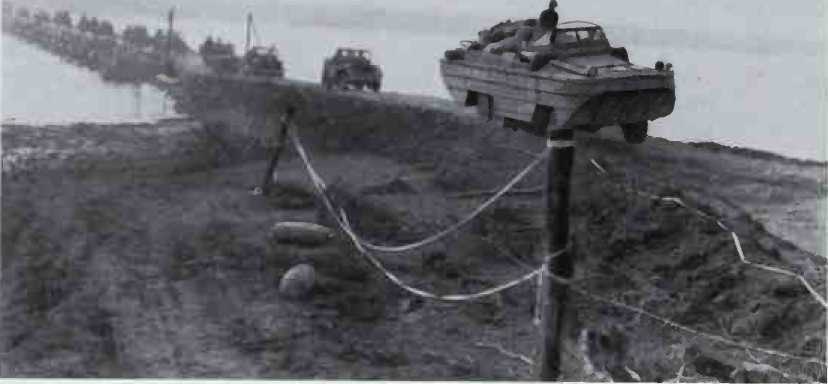
A Supplies for the 9th Army arrive by D. U.K. W. and jeep on the east bank of the Rhine.
Coming across this passage in Crusade in Europe, Lord Alanbrooke refers to an entry in his diary made at the close of that same March 24, claiming that Eisenhower’s remarks resulted from a misunderstanding, and that he had not in fact "seen the light” that day near Xanten. He wrote in 1949:
"To the best of my memory I congratulated him heartily on his success and said that, as matters had turned out, his policy was now the correct one; that, with the German in his defeated condition, no dangers now existed in a dispersal of effort.”
Thus Brooke corrects the remark attributed to him (on this occasion) by Eisenhower. Obviously there is a difference between the two versions. Nevertheless, it does not necessarily follow that Eisenhower was mistaken in defending his strategic plans, unless it can be shown that the German armies would have fallen into the state of ruin and confusion noted by BroOke that March 25 evening had not Operations "Lumberjack” and "Undertone” taken place.
On March 25 and 28, two further events of comparable scale and importance took place on the 12th Army Group’s front: firstly, the collapse of the German 15th Army, whose task it was to contain the enemy within the Remagen bridgehead; and secondly, adding its effect to the clean breakthrough by the American 1st Army, the crossing of the Main at the Aschaffenburg and Hanau bridges by the American 3rd Army. This manoeuvre followed from a carefully prepared plan of General Bradley’s after the launching of Operation "Lumberjack”, which was given its final touches following the surprise assault on Remagen. He describes it as follows in A Soldier’s Story:
"Now that Hodges had established the Remagen bridgehead to the south of Bonn, he was to trace that original pattern. First he would speed his tanks down the autobahn where it ran through Limburg on the road to Frankfurt. At Limburg he was to turn east up the Lahn Valley to Giessen. There he would join Patton’s pincer coming up from the Main.
"The First and Third Armies would then advance abreast of one another in a parallel column with Hodges on the inside, Patton on his flank, up the broad Wetteran corridor toward a union with Simpson. Then while Hodges and Simpson locked themselves around the Ruhr preparatory to cleaning it out, Patton would face his Army to the east and be prepared to advance toward the oncoming Russians.”
So it was, but according to Kesselring, the execution of Bradley’s plan was considerably eased by Model’s preconceived ideas of the enemy’s intentions. The commander of Army Group "B” was obsessed with his right flank, fearing an attack down the eastern bank of the Rhine aimed at an assault on the Ruhr industrial complex from the south; and he was deaf to all telephone calls from his superior, remonstrating with him for leaving his centre thinly protected. This was a serious mistake.




 World History
World History









